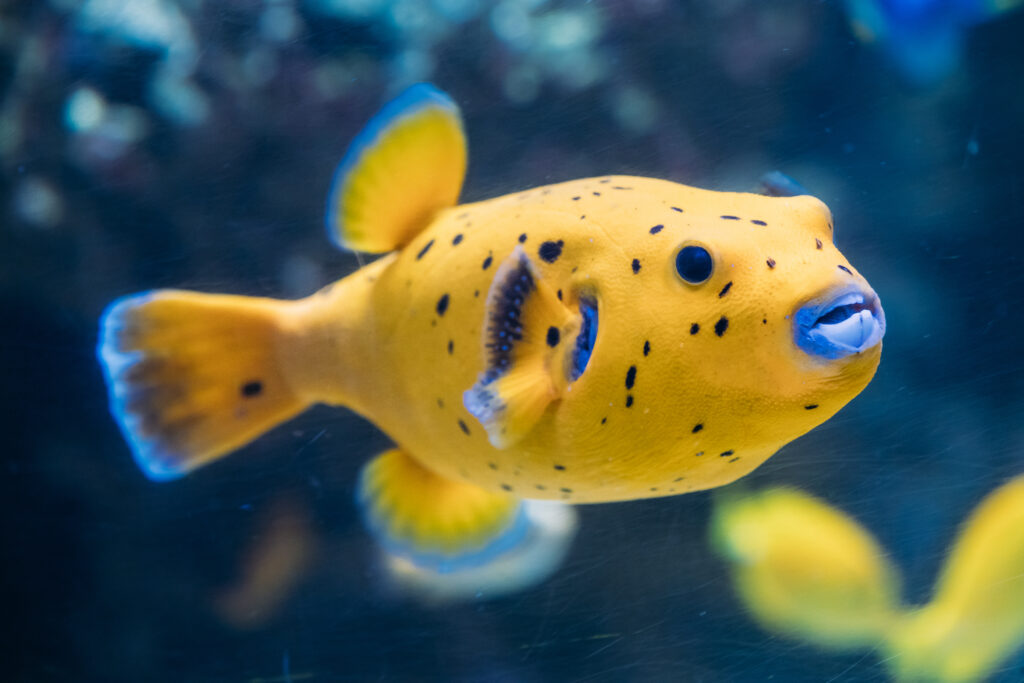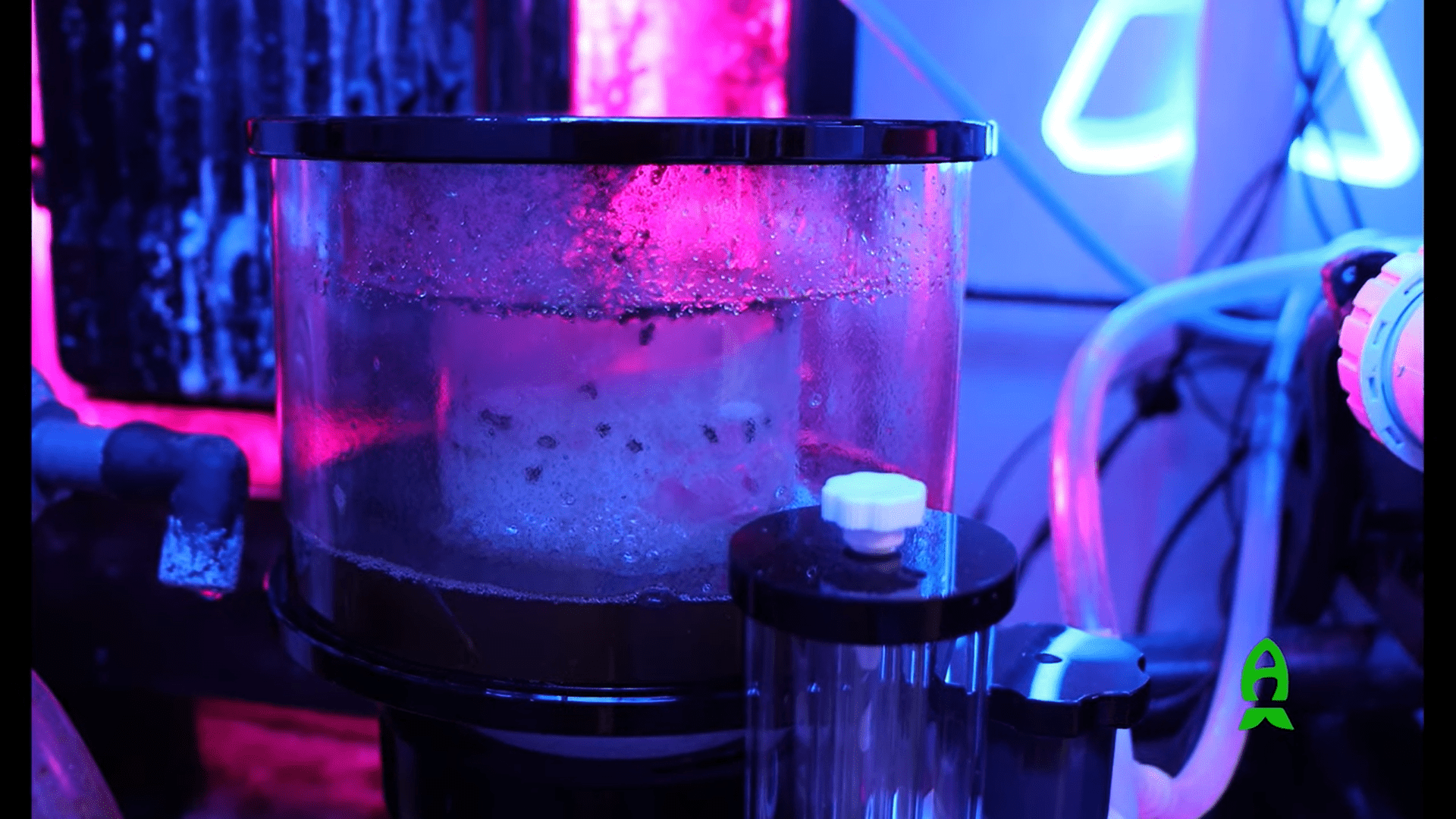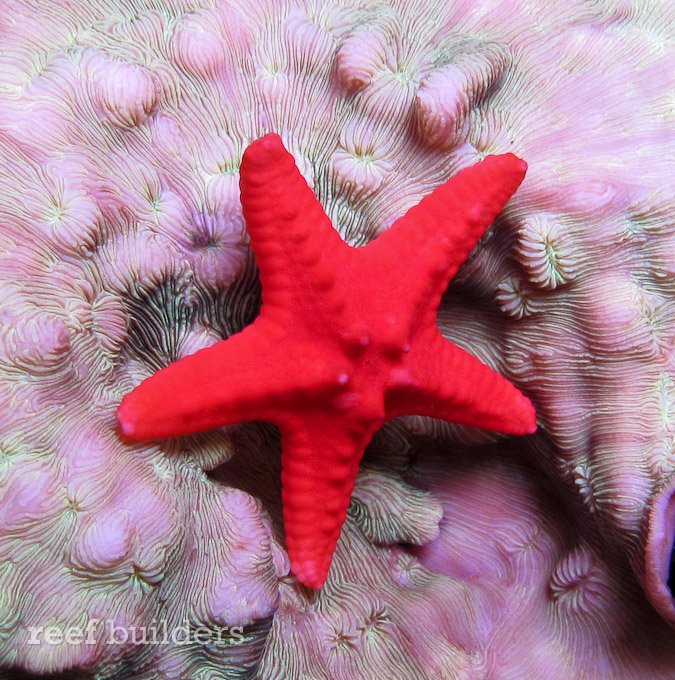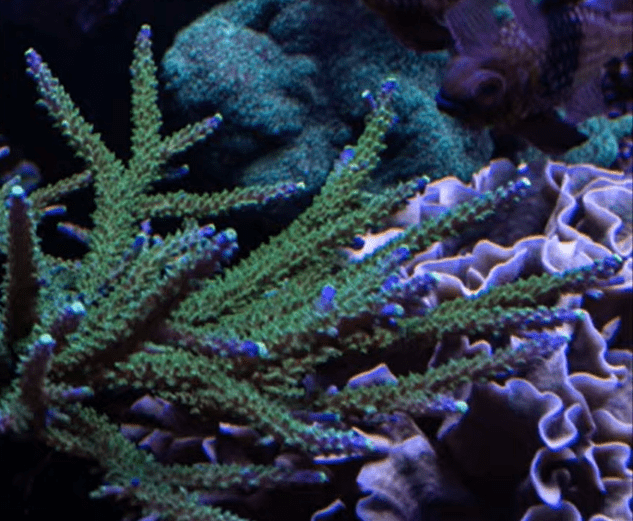Have you ever come across a fish that looks like it’s perpetually wearing a clown’s outfit? That’s the Dogface Puffer Fish for you! With its distinctive markings and comical expression, this unique ocean dweller has certainly earned its reputation as a showstopper.
In this article, we will dive into the various features that make the Dogface Puffer Fish stand out from the crowd. Let’s dive in!
Quick Facts 
| Scientific Name: | Arothron nigropunctatus |
| Other Names / Common Species: | Black Spotted Puffer, Black-Spotted Pufferfish, Blackspotted Blaasop, Blackspotted Toadfish, Dog-Faced Puffer |
| Reef Safe: | Yes with caution |
| Lifespan: | 10 yrs |
| Size: | 12 in |
| Care: | Medium due to its dental needs |
| Diet: | Clams, mussels, shrimp, squid, and hard-shelled seafood |
| Water Parameters: | 72-78F, 8.1-8.4pH, 8-12dKH, 1.020-1.025SG |
| Tank Size: | 90 gallons |
| Behavior: | Peaceful |
| Breeding Difficulty: | Difficult |
Species Summary
The Dog Face Puffer fish, scientifically known as Arothron nigropunctatus, is a fascinating marine species cherished in the aquarium trade for its distinct personality and appearance.
Native to the warm waters of the Indo-Pacific Ocean, these fish are commonly found meandering around coral reefs and lagoons. Recognized for their expressive “dog-like” faces, from which they derive their name, dog face puffers are both an endearing and captivating addition to any large marine aquarium.
Appearance
Sporting a robust and pliable body, the dog face puffer is a delightful spectacle of nature’s design. Their coloration varies widely, from muted tans and greys to vibrant yellows and greens, often adorned with dark spots or blotches that serve as camouflage against predators in the wild.
In addition to its color-changing abilities, its balloon-like body, large eyes, and puckered mouth give it an adorable, yet quirky, charm.
The “puppy dog” eyes add to their allure, lending them an almost cartoonish look that is hard to resist. These adaptive colors and patterns not only provide defense mechanisms in their natural habitat but also make each fish uniquely attractive in a home tank.
Author Note: Other color variations are Yellow Dogface Puffer and Black Dogfaced Puffer.
How about its self defense skills?
Beyond its striking appearance, the Dogface Puffer Fish also possesses some fascinating survival mechanisms. For instance, it has the remarkable ability to inflate its body with water or air, doubling in size to deter potential predators. It can also produce a toxic substance called tetrodotoxin, making it one of the few poisonous fish species in the world.
Lifespan
Dog-faced puffers have a lifespan of 10 or more years in captivity which is a longer commitment than many other fish out there. Their longevity is closely linked to the quality of their environment, diet, and overall care they receive.
Average Size
When it comes to size, the dog face puffer grows to an average length of about 12 inches (30 cm) in captivity. Their size demands respect and plenty of space for them to swim and explore, a crucial factor to consider before welcoming them into your aquatic family.
Dog-Faced Puffer Care
Providing top-notch care for your dog face puffer is an engaging and fulfilling endeavor. This begins with a well-maintained tank that mimics their natural oceanic habitat, ensuring they have the space, clean water, and hiding spots necessary for a stress-free life.
Author Note: We were going to say that caring for a dogface puffer was easy but we changed it to intermediate due to its dental needs.
Tank Size
The recommended minimum tank size for ONE dogface puffer is 90 gallons, a volume that caters to their active swimming habits and growth potential. For aquarists who wish to house a community, larger tanks are essential to prevent territorial disputes and overstocking issues.
Water Parameters
Dog face puffers are sensitive to their aquatic environment. It’s imperative to maintain specific water parameters to keep these puffers healthy:
- Water temperature: 72-78°F (22-25.5°C)
- pH levels: 8.1-8.4
- Water hardness: 8-12 dKH
- Specific gravity: 1.020-1.025
Regular monitoring and adjustments are part of the routine care to maintain these parameters within the correct range.
Teeth Care and Trimming
One of the most distinctive features of the dog face puffer is their ever-growing beak-like teeth. In the wild, the constant grinding on coral and hard-shelled prey keeps their teeth at a manageable length.
In captivity, however, their teeth can become overgrown without proper care. Offering them hard-shelled foods is a natural way to help manage tooth length. They also grind their teeth on rocks so if that is an option for you, it might be worth giving it a try.
Author Note: In some cases, if their teeth prevent proper feeding, a vet may need to step in for a trimming procedure.

Tank Setup
Your tank should be a slice of the reef, replete with live rock formations and ample hiding spots that offer safety and contribute to the biological filtration. Strong, efficient filtration is non-negotiable, as puffers are messy eaters and produce a significant amount of waste.
Consider a protein skimmer and regular water changes to manage the water quality effectively. Don’t worry we got your back, check our Best Protein Skimmers post.
Are Dogface Puffers Reef Safe?
Dog faced puffers could be reef safe when implementing some safety measures. They should be housed with caution in reef tanks, preferably with more robust coral species and invertebrates that are less likely to be snacked on.
Although generally peaceful, dogface puffers are notorious for their tendency to nibble at and potentially consume some invertebrates and corals, leading many to conclude that they are not entirely reef safe.
Common Possible Diseases & Prevention
Dog face puffers are not immune to common marine fish diseases such as ich (Cryptocaryon irritans) and marine velvet (Amyloodinium ocellatum). Let’s expand a bit more on these diseases.
- Cryptocaryon irritans. Cryptocaryon is a tiny organism covered in little hairs, found in many kinds of saltwater settings. This little bugger can burrow into the skin and gills of our fish friends. How sick it makes the fish depends on how strong the fish’s defenses are. Some may just get a couple of white dots, while others might feel really uncomfortable, not want to eat, act tired, have a hard time breathing, and in the worst cases, it can even lead to the fish passing away.
- Amyloodinium ocellatum. This is often just called “marine velvet” because it’s like a velvet blanket that covers the fish, but this blanket is definitely not cozy. If a fish gets marine velvet, it might stop eating, breathe really fast because it’s hard to get air, and it might not swim around much. If we look closely, we might see a dusty, gold or rusty “velvet” coat on the fish, and that’s the bug doing its not-so-nice work.
To ward off these ailments, it’s critical to quarantine new fish before introducing them to the main tank, maintain pristine water quality, and provide a varied, nutritious diet to bolster their immune systems.
Author Note: Being attentive to any behavioral changes or signs of distress can also lead to early detection and treatment of health issues. So don’t disregard weird behaviors and take action promptly.
Food & Diet
In the wild, dogface puffers feed on a variety of mollusks, corals, and crustaceans, which helps keep their teeth in check. In your tank, you should emulate this diet by offering a mix of clams, mussels, shrimp, squid, and occasionally, hard-shelled seafood to aid in dental health.
This dietary diversity is not only critical for their nutritional needs but also for preventing diseases related to malnutrition.
Behavior & Temperament
Typically peaceful and somewhat solitary, dog-faced puffers may exhibit territorial behaviors and aggression towards conspecifics or similar-looking species.
They enjoy their own company and may not be as active as other fish, but they are curious about their environment and can be quite interactive, especially during feeding times.
Dog-Faced Puffer Tank Mates & Predators
Selecting compatible tank mates for your dogface puffer involves choosing peaceful fish that are not small enough to be mistaken for food. It’s also wise to avoid predatory species or aggressive fish that could harm or unduly stress your puffer.
Some compatible tank mates include larger, peaceful fish that respect the puffer’s space and do not compete aggressively for food. A few options include:
Not recommended tank mates are:

Breeding
Breeding dog face puffers in a home aquarium is an infrequent and complex endeavor. In other words, we don’t recommend it since we couldn’t find a successful method to share in this guide.
The specific conditions needed for breeding, including precise water parameters and the natural reproductive behaviors of these fish, make successful captive breeding a rare achievement.
For the most part, aquarists enjoy these creatures for their individual charm rather than their potential for propagation.
Wrapping Up
We hope you enjoyed reading this guide as much as we enjoyed writing it (it’s not common to write about a fish-dog).
So, are you ready for a cool, challenging and rewarding experience? Caring for a dogface puffer is a rewarding adventure that requires a dedicated aquarist willing to meet their specific needs. From their spacious tank requirements and specialized diet to their distinct personality and long lifespan, dog face puffers are truly one of the more unique and engaging marine fish one can keep.
With the right care and commitment, these “puppy dogs” of the sea can become a beloved centerpiece of your aquatic ecosystem for years to come. We have other cool care guides to learn from and sharing is caring so feel free to tag us on Facebook with photos of your dog faced puffer!



